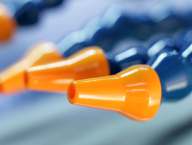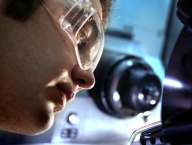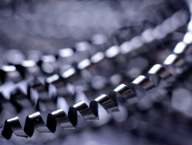New cranio facial manual a4




EXPANDING PROVEN CONCEPTS
CAT-2036-02 (C344)
CRANIO FACIAL Reconstruction




Dear Customers and Colleagues
Today, Dental Implants have become an indispensable part of Dental treatment options. With the globalization of medical infrastructures and higher standards of living, implant applications have rapidly become common.
Southern Implants has been a manufacturer and distributor of Dental Implants since 1987. Today, the Southern group is recognized as a leading bio-medical engineering entity, with major intellectual property and capabilities in implantable devices, arthroplasties, tissue regeneration, stem cells and cryoscience. The top-end professional users, who want more choices, have driven the product range expansion to enormous and exciting heights. Striving for excellence and meeting customer needs has lead to our wide product range characterized by numerous unique and innovative products which include:
3 interfaces: External hex, Internal morse taper/octagon, and Tri-nex.
Many products optimized for primary stability and suited for immediate loading.
The only angled-top tapered screw-form 12° and 24° Co-Axis implant.
Implant lengths from 6mm to 20mm and diameters from 2.90mm to 10mm.
A surface which continues to out-perform that which it is trialed against.
Color-coded components for easy part recognition.
55° Zygomatic implant, optimized for load distribution.
Compatibility with major brands, giving the patient more options.
The MAX, wide diameter implant for molar teeth replacement.
Striving for excellence is synonymous with the search to improve. At Southern the development starts with computer simulation and Finite Element Modeling. This is followed by extensive laboratory trials and testing. Finally, clinical research has taken on a new dimension in our overall strategy where our preference is for independent RCTs.
Our sincere thanks to all specialists, dentists and technicians who give continual feedback, suggestions and input. The products here are our interpretation of your needs.
Graham Blackbeard
Managing Director
Southern Implants
Why Southern Implants?
Southern Implants was established in 1987 as a manufacturer and distributor of dental implants. At this time the science on a worldwide basis was still in it's infancy. Southern implants has been a pioneer in this field for the last 21 years and has contributed extensively to enhancements with respects to the osseointegration of implant devices, surgical techniques, patient education and options of treatment.
The company is focused on the top-end specialist sector of the implant market. The product range is constantly being expanded to incorporate the newest technologies and trends. Where many of our competitors are rationalizing their product range, Southern is offering more choices.
The implants are made from ASTM-F67-95 Grade 4 pure titanium, with a tensile strength of 550 MPa. The surface is enhanced with abrasion and chemical conditioning. The surface has been proven by way of extensive animal and clinical trials and has been in use for more than 15 years.
Southern Implants is not only the leading implant company in Southern Africa, but is a significant role player in the USA, the UK, Europe and Australasia. Manufacturing plants are situated in Irene, South Africa and Irvine, California. Each Plant produces 60 000 implants per annum.
Design & Layout by Ruan Pienaar
Introduction and Welcoming Letter. Front Cover
IE Implant - Instruction for Use. Page 02
List of Figures. Page 03
IE Implants & components. Page 04
Prosthetic Options - IE Implant. Page 05
Ball Abutment for use with IE Implant - OBE. Page 06
Transcutaneous Standard Abutment - ABE. Page 07
Southern Implants' Enhanced Surface. Page 08
Publication"Sinus Reactions to Immediate Loaded Zygoma Implants: A Clinical and Radiological Study"Preferred Positioning of Zygomatic Implants. Page 09
Zygomatic & Oncology Implants. Page 11
Operative Procedures. Page 12
Postoperative ManagementSecond Stage SurgeryNon-integration of Implant. Page 13
Zygomatic Implants & components. Page 14
Prosthetic Options - Zygomatic Implant. Page 15
Poster Presentation"A Protocol for Maxillary Reconstruction Following Gunshot and Oncology Resection". Page 16-17
I-ZYG Zygomatic TrayZygomatic Instruments. Page 20
CertificatesComplimentary Manuals & Instructions
Labeling Symbols. Back Cover
Contact Details (Local and International). Back Cover
Instructions for Use
Extra Oral implants have a number of different indications for use, such as retaining cranio facial prosthesis' and bone conductor hearing aids. The
IE Implant
general placement procedure is similar in most extra oral cases and
therefore an example for an auricular prosthesis will be used.
The availability of bone as well as ideal placement for attachment of the prosthesis are considerations that need to be taken into account when
dealing with extra oral implants. Case planning with the prosthesists making use of CT scans or other case planning devices, is highly recommended. At this stage the length of implant would be determined from the availability of
Prepare the implant site by removing any remaining tissue or ligatures from the area. Make appropriate incisions and pull back the skin - exposing the implant site. The reduction of skin thickness is important to avoiding subsequent soft-tissue problems. Multiple authors have advocated subcutaneous skin reduction, fixed non-mobile skin and absence of hair sometimes requiring grafting of non hair-bearing skin to periosteum. The reduction of skin can take place at implant placement or abutment connection. This excision of a portion of dermal and subcutaneous tissue often includes removal of the adnexal structures, muscle, blood vessels and nerves. This is to aid in fixing the skin to the periosteum, to minimize mobility and remove glandular components.
Start the drilling process by using a dedicated round burr (Fig.1). The pilot hole is then created by using a slightly wider (Ø2.00mm) dedicated drill. (Fig. 2).
The final drill (Ø3.00mm) will then be used to prepare the site. Drilling is done at 1000 to 2000 rpm with copious irrigation (Fig.3).
The IE implant is self tapping by design, however, depending on the hardness of the bone, a tap can be used. Taps cut thread into bony walls of the prepared implant site, easing the placement of the implant in hard bone (Fig.4).
The site is now ready for an implant to be placed. Remove the implant from the sterile packaging tube either with a wrench or handpiece bit (I-CON-X) (Fig. 5A & 5B). Set the torque on the handpiece to 25Ncm. Place the implant with final position such that the platform of the implant is flush with the bone.
Remove the fixture mount and place the cover screw or temporary healing abutment (Fig. 6A & 6B). Cover the site (Fig. 7).
These Implants are machined from "Unalloyed Titanium for surgical implant application", ASTM F67-95 Grade 4. Although there are slight variations from one batch to another, a typical chemical composition is: Nitrogen 0.01%; Carbon 0.02%; Hydrogen 0.002%; Iron 0.07%; Oxygen 0.14%; balance Titanium, and has a tensile strength 550 Mpa. Such a material exceeds the chemical requirements of Grade 1, and has been classified as Grade 4 due to the superior strength (Grade 1 has a minimum strength of 240 Mpa).
The material chosen for these IE implants, makes them extremely tough and resistant to fatigue failure. The implants are surface enhanced to facilitate secure anchorage and to reduce the need for Hyperbaric Oxygen therapy.
02 I Southern Implants I Cranio Facial Reconstruction Manual
IE Implant
IE Implants arepre-mounted and
are available inlengths:
3mm code: IE3
4mm code: IE4
6mm code: IE6
SC4 Cover Screw
TBE Healing Abutments
IE Drilling Sequence
(for thread cutting)
04 I Southern Implants I Cranio Facial Reconstruction Manual
Prosthetic Options: IE Implant
Analogue
Southern Implants Series 1 Screws
Series 1 Screws (M1.4)
10-15Ncm
Head Diameter 2.25mm
GSS1 GSU1 GSH1 TSS1 TSU1 TSH1
Ball Abutment for use with IE Implant - OBE
OBE Abutment
This component is used for clip-on prosthetic parts. The PC2 plastic clip must be incorporated into the prosthesis. Alternatively the Silicone prosthetic part can be made to adhere directly to this ball abutment
The abutment is attached to the implant at second stage surgery upon removal of the SC4 cover screw or the TBE temporary abutment. Second stage surgery is commonly done by way of an incision over the implant, reflection of the skin, securing the abutment and then suturing the skin around the abutment. An alternative method is to punch a cylinder of skin out, above the implant. This is done using the handpiece-driven tissue cutter, I-TC1. Ensure that the hex engages the hex of the implant. Place the OBE abutment, tightening the screw to 20Ncm using the 1.22 Hexdriver (I-HD-M). To avoid inflamation of the tissue it is imperative that the skin is thinned down around the implant.
A rubber-based impression is taken of the region. The laboratory analogues are then inserted into the sockets created by the OBE's in the impression material. The model is then cast, incorporating the stem of the AO2.
Laboratory analogue,
06 I Southern Implants I Cranio Facial Reconstruction Manual
Transcutaneous Standard Abutment - ABE
ABE Abutment
For retention of prosthetic parts, this standard abutment is most commonly used. A bar-type framework is constructed on top of the standard abutment, linking the implants to one another. These ABE abutments have transcutaneous heights, L, of 4 / 5.5 / 7 and 8.5mm.
The standard abutment is connected to the implant at second stage surgery upon removal of the SC4 cover screw or TBE temporary abutment. Second stage surgery is commonly done by way of an incision over the implant, reflection of the skin,
securing the abutment and then suturing the skin around the abutment. An alternative method is to punch a cylinder of skin out, above the implant. This is done using the handpiece driven tissue cutter, I-TC1. The standard abutment is secured using the abutment driver, I-AD. A Torque Wrench with a bit, I-WI-A, can also be used (tighten to 20 Ncm).
After abutment placement, the head of the abutment can be protected and kept clean during healing by screwing the healing cap, HB3, into the top of the abutment using a I-AD abutment driver. A rubber-based impression is taken when healing is complete by removing the healing caps and replacing them with two-part CB1 impression copings. These impression copings require an impression tray with a "window" in order for the screw of the CB1 to be accessible. When the impression material has set, the CB1 screws are loosened completely and the impression can then be withdrawn. Abutment replicas (lab analogues) are then attached to the CB1's in the impression and the model is cast. The gold cylinder, GCP3 or GCP4, is fitted to the model and the bar is waxed up onto the gold cylinder. The gold cylinder is then loosened from the model and invested with the wax bar for the cap-on technique. An alternative is to solder a gold bar to the gold cylinder on the model.
to be incorporated
External hex for
external environment
Abutment cylinder
Internal hex for location
and anti-rotation of implant
Southern Implants' Enhanced Surface
The Southern enhanced surface is not a "coating", it is an abraided rough surface of Rutile Titanium. This is the same dense form of titanium common to "machined" surface implants. (the anodic oxidation surfaces are not Rutile Titanium; they are a mixture of anatase and amorphous titanium which are less dense and softer forms of titanium).
A. The first experimentation with this Southern Enhanced surface was in 1992. After extensive
validation it was put into widespread clinical use in 1997. It is achieved by a subtractive process in which specifically sized and shaped, sharp cornered, Alumina particles (Al203) are blasted with decontaminated air onto the implant surface with controlled pressure, displacement and time. Every batch of A1203 particles are subject to SEM analysis to ensure consistent shape and size.
The particle size we use is supported by the work of Soskalne (Israel) and Wennerberg (Sweden) on the one hand and Ronald (Norway) on the other. Based on their research, greatest bone to titanium bond strength is obtained with abrasion particles greater that 75µm and less than 170µm.
C. Szmukler-Moncler has analyzed and compared the popular implant surfaces in publications and a
presentation at the AO, San Francisco 2004. He reports that the Southern Surface is remarkably consistent and free of contaminants whilst those that are acid etched or oxidized are shown to be highly variable. It is extremely difficult to control acid etching and oxidation in an industrial manufacturing process. This is one reason why Southern does not use acid etching or anodic oxidation.
D. There seems to be consensus in the literature that "moderately rough" surfaces have no great
risks for the patient and are therefore safe to use. Moderately rough was defined by Albrektsson as S a 1.0 to 2.0µm (applied Osseointegration Research Vol 5, 2006) and our surface has S
1.43 in one published study and S
a = 1.55 on implants recently analyzed by Prof Ann Wennerberg
Dr Mats Wikström, Chief of Clinics, Branemark Center, Goteborg, in 2007 concluded that the Southern surface is one of the three best documented moderately rough surfaces in the market.
Prof Alan Payne, Oral Implantology Research Group, University of Otago, is conducting Randomized Clinical Trials (RCTs) involving Southern Implants rough surface. 2008 signifies the 10 year follow-up. The 8 year and 5 year results are published in Cochrane Collaboration reports.
In conclusion, it is a well documented surface with a consistent manufacturing process and holds extremely low risk for the patient.
08 I Southern Implants I Cranio Facial Reconstruction Manual
Eur J Oral Implantol 2008; 1(1):53-60
Preferred Positioning of Zygomatic Implants
Preferred position of Zygomatic implants is as shown here, with minimal penetration of the sinus and greaterengagement of the sinus well. - Clinical photographs by courtesy of Prof D Howes and Dr. G Boyes-Varley.
Zygomatic & Oncology Implants
This manual is produced as an adjunct to the Southern Implants Zygomatic Course, and as an instruction sheet for
use before and during placement of these Zygomatic implants. It is not intended to be a guide for basic surgical
techniques, as it is essential that practitioners using these implants are already experienced Maxillo-
Facial or Cranio-Facial surgeons.
The main indications for the placement of Zygomatic implants are:
1. Patients who are fully edentulous in the maxilla, especially those with moderate to severe bone resorption.
2.
Patients who have unilateral or bilateral posterior maxillary edentulism, & with moderate to severe bone loss.
Patients who have had ablative cancer surgery or who have suffered avulsive trauma to the middle third of the facial skeleton.
Pre-operative examination and treatment planning:
This must be done by the full team responsible for the complete treatment of the patient, usually a restorative Dentist or Prosthodontist in conjunction with a Maxillo-Facial or Cranio-Facial Surgeon. A full medical and dental history must be taken, with emphasis placed on the presence of soft tissue and hard tissue pathology and ensuring that the maxillary sinuses are clinically symptom-free. In addition, jaw relationships and resorption patterns must be noted.
As with any implant patient, a radiographic assessment is essential. As far as the Zygomatic protocol is concerned, the main objectives are twofold:
To detect the presence of any pathology in the maxillary sinuses, bearing in mind that the thickness of the antral mucosa should not exceed 6mm.
To evaluate the volume of zygomatic bone available.
The following radiographic views should be taken as necessary:
Panoramic view - for detection of pathology changes within the maxilla as well as anatomical structures.
Occipitomental views to assess the extent of the maxillary sinus as well as the presence of sinus pathology.
Lateral cephalogram to assess jaw relationships.
CT scans. These must be in form of both axial cuts and reformatted images, as these give an excellent assessment of the maxillary sinuses. In the case of cancer and trauma surgery patients, 3D reconstructions are useful.
Intra oral x-rays. These are essential to supplement the other views in cases where partially edentulous posterior segments are being reconstructed.
Patient Preparation:
As zygomatic implants are generally placed under general anaesthetics, the standard protocol for patient preparation is adhered to. The part of the face above the zygomatic arch must be left uncovered when draping the patient or securing the endotrachael tube. Haemostasis is enhanced by the use of a suitable local anaesthetic infiltration in the entire operative area.
The Current Surgical Procedure is:
A crestal incision is made from just anterior to the maxillary tuberosity on one side to the same point on the other side. Three vertical releasing incisions are made in the second molar regions and the midline. These three incisions facilitate flap mobilization beyond the infraorbital margin. In unilateral cases, a hemimaxillary approach is used.
The buccal mucoperiosteal flaps are raised to expose the infraorbital nerve, the body of the zygoma and the zygomatic arch. A palatal flap is raised to expose the alveolar bone . The periosteum in the region of the upper molar teeth is incised to enhance flap mobility. A modified channel retractor is placed on the upper border of the zygomatic arch.
A window is cut on the lateral aspect of the maxillary antrum and the block of bone is removed. The lining of
the sinus is reflected, attempting
intact if possible.
NB: A perforation of the lining is not a major problem but thorough
reflection of the lining is essential (fig. 1).
The access cavity of the implant into the body of the zygoma is made through the antral window, and the tip of the placement device is positioned in the access cavity. This acts as a guide for the correct alignment of the implant on the alveolar ridge (fig. 2).
The entrance point on the alveolus is made using a round bur. The penetration of the implant site is continued by means of a 2.9mm twist drill, a 3.4mm counterbore and a 3.4mm twist drill (fig. 3).
The depth of the prepared implant site and the implant head angulation are gauged by the use of the angled depth indicator.
Before inserting the implant, ensure that the implant site is free of soft tissue remnants. Initial insertion of the implant is carried out using the machine connector to handpiece with the torque control set at 45Ncm at 15rpm.
During insertion: 1. The implant must follow the prepared path of insertion.
During insertion: 2. Soft tissue must not be caught up on the implant surface.
During insertion: 3. Adequate coolant must be applied to both alveolar and zygomatic bone.
During insertion: 4. The torque controller is set at 45Ncm. Once this level is reached, further insertion is achieved manually using the onion driver. When insertion is complete, rotate the implant head so that the hex is aligned correctly. The fixture mount is then removed and the cover screw placed by hand.
Suturing is carried out by the technique of choice using resorbable sutures. Thereafter a long-acting local anaesthetic solution is injected to control postoperative pain.
12 I Southern Implants I Cranio Facial Reconstruction Manual
A further 8mg Decadron is given for 7 hours postoperatively. In addition, a course of oral antibiotics is given to the patient and a suitable analgesic regimen is prescribed. Occasionally a patient will complain of a feeling of congestion of the maxillary sinuses.In order to address this, a combination of nasal decongestant and cortisone nose drops is advised.
Patients may also complain of paraesthesia or anaesthesia in the distribution of the infraorbital nerve. This is transient and is due to stretching of the nerves during the operative procedure. These patients should therefore be counseled accordingly.
Modifications to the existing prosthesis will be necessary so that it can be worn during the integration phase. This should be carried out by the Prosthodontist or restorative Dentist.
Second Stage Surgery
It is common for these implants to be loaded immediately (same day or within a week of placement). However the well documented and conservative protocol, is exposure of implants performed 4 to 6 months after placement. This procedure may be carried out either under local or under general anaesthesia. It is recommended that impressions be taken at
the time of implant exposure so that they can be splinted at
the earliest opportunity. This is
absolutely crucial in cases where
bone grafting procedures have been performed. The surgical
exposure of the cover screws by means of a crestal incision and their replacement with temporary healing abutments. Suturing is then carried out according to the surgeons preference.
Non-integration of Implant
Should this occur, the implant should be removed. This is achieved by connecting a fixture mount and removing the implant by means of the onion driver. If any soft tissue is present in the implant site, this must be curetted out. In the unlikely event of the fracture of an implant, the coronal part is removed and the rest is left in site. Implants which have been removed due to non-integration may be replaced after a healing period of one year.
55° Zygomatic & Oncology Implants
Zygomatic Implants are available in lengths:
Oncology Implants are available in lengths:27mm
20mm on all lengths
SCU2 Cover Screw
TB & WB Healing Abutments
Zygomatic Drilling Sequence
DRILLING SEQUENCE:
Step1: Pilot Drill to full depth of implant 2: Countersink 3: Diameter 3.4mm Drill to full depth 4: Place Implant
Please note: Due to the nature of the long drills, a special surgical insert and 32:1 reduction handpiece is necessary for the placement of these implants.
14 I Southern Implants I Cranio Facial Reconstruction Manual
Prosthetic Options: Zygomatic & Oncology Platform
Analogue
GC-NX-40 (Non-Hex)
TCB 1nh (Non-Hex)
TCB 5nh (Non-Hex)
CC-NX-40 (Non-Hex)
Uses 3 Series Screws
CIA-EX-40 (Engaging)
ZYG-55 / ONC-55
SB-17-TT (Non-Hex)
Compact Conical Abutment
Analogue for uncut DBN
Uses 3 Series Z Screws
16 I Southern Implants I Cranio Facial Reconstruction Manual
I-ZYG Zygomatic Tray
* Additional Instruments: These are optional extras to assist with placement and can be manufactured on request
20 I Southern Implants I Cranio Facial Reconstruction Manual
Complimentary Manuals & Instructions:
Externally Hexed Product Catalogue.CAT-2020
Tri-Nex Product Catalogue.CAT-2004
IT Product Catalogue.CAT-2005
Patient Information Brochure.CAT-2022
Patient Homecare Brochure.CAT-2023
Overdenture Information Brochure.
Zygomatic Information Brochure.
Instrument Catalogue.CAT-2006
Prosthetic & Laboratory Manual.CAT-2001
TMJ Prosthesis Catalogue.CAT-2018
Passive Abutments.CAT-1008
One Piece Implants.CAT-1083
Finger Implants Catalogue.CAT-2010
First & Secondary Stage Surgery Manual.CAT-2024
Instructions for use . PRO-6038
Labeling Symbols:
The following symbols are used on our packaging labels and they indicate the following:
1: "Use by"
2: "Batch code"
3: "Do not reuse"
STERILE R
4: "Sterilization using Irradiation"
5: "Caution"
6: "Consult instruction for use"
7: CE mark
Southern Implants (Pty) Ltd. Irene, South Africa
EXPANDING PROVEN CONCEPTS
South Africa
Americas / Asia
New Zealand
Southern Implants (Pty) Ltd.
Southern Implants Inc.
Southern Implants UK
Henry Schein I Halas Dental
Southern Implants Ltd NZ
Southern Implants
Tel: +27 12 667 1046
Tel: +1 949 273 8505
Tel: +44 208 998 0063
Tel: +61 2 9697 6288
Tel: 0800 246 752
Tel: +49 7121 490 620
Fax: +27 12 6671029
Fax: +1 949 273 8508
Fax: +44 208 997 0580
Fax: +61 2 9697 6250
Cel: +64 2189 4243
Fax: +49 7121 491 717
Fax: +64 9 430 2836
www.southernimplants.us
[email protected]
www.southernimplants.de
Spain / Portugal
Southern Implants
Tel: +30 210 898 2817
Tel: +32 11 822 650
Tel: +46 31 291078
Tel: +351 214 693 332
Tel: +212 343 5233
Tel: +64 61 225 152
Fax: +30 210 595 2543
Fax: +32 11 822 651
Fax: +46 706 150078
Fax: +351 214 693 329
Fax: +64 61 235 630
Source: http://www.southernimplants.de/sidownloads/CranioFacialManual.pdf
The Exclusive Vitamin RECOMMENDED DIETARY INTAKE FOR μg vitamin B per day Vitamin B is found naturally in all foods of animal origin and a few foods that have been fortified.Symptoms of vitamin B deficiency can take several years to develop as liver stores may be large and vitamin B is recycled internally. In older people, however, the ability to absorb vitamin B from
County Behavioral Health Directors Association of California Medicines Used in the Treatment of Substance Use Disorders: Implications for Integrated Behavioral Health December 11, 2015 Mark Stanford, PhD Sr Director of Integrated Behavioral Health Encompass Community Services Associate Professor Neuroscience, Cabrillo College Clinical Consultant for Stanford University School of Medicine









